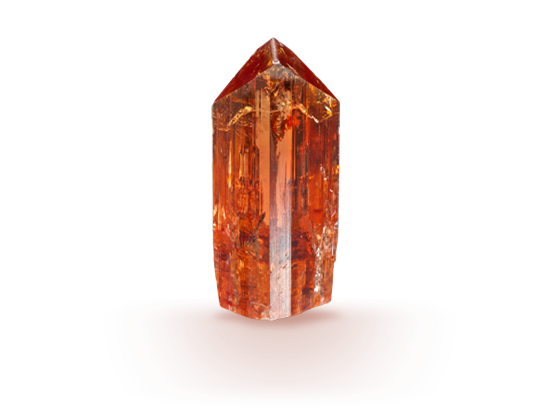OVERVIEW
Topaz actually has an exceptionally wide color range that, besides brown, includes various tones and saturations of blue, green, yellow, orange, red, pink, and purple. Colorless topaz is plentiful, and is often treated to give it a blue color. Topaz is also pleochroic, meaning that the gem can show different colors in different crystal directions.
Many consumers know topaz as simply an inexpensive blue gem. They’re surprised to learn that its blue color is hardly ever natural: It’s almost always caused by treatment. They might also be surprised to know that topaz has so many more colors to offer gem lovers, including pinks and purples that rival the finest fancy sapphires.
Topaz is allochromatic, which means that its color is caused by impurity elements or defects in its crystal structure rather than by an element of its basic chemical composition. The element chromium causes natural pink, red, and violet-to-purple colors in topaz. Imperfections at the atomic level in topaz crystal structure can cause yellow, brown, and blue color. Brown is a common topaz color, and the gem is sometimes mistakenly called “smoky quartz.”
- Mineral: Topaz
- Chemistry: Al2(F,OH)2SiO4
- Color: Yellow, orange, brown, pink to red to purple red, blue, light green and colorless
- Refractive index: 1.619 to 1.627
- Birefringence: 0.008 to 0.010
- Specific gravity: 3.53
- Mohs Hardness: 8
WHERE IS IT FOUND ?
Minas Gerais, a state in Brazil, is one of the most important sources for high-quality topaz, which has been mined there for more than two centuries. Yellow to orange, red, pink, violet and blends of red with orange or purple are some of the colors unearthed here. The nearby town of Ouro Preto is a fitting companion. In this UNESCO world heritage site, majestic colonial churches checker the skyline and quaint cobblestone streets crisscross the city.
Northwestern Pakistan is known for producing pink topaz. Ghundao Hill, close to the small town of Katlang, has been mined since 1972. The most sought-after shade of pink topaz from Katlang has a tinge of violet, which some in the gem trade call cyclamen pink. But even at Ghundao Hill, only rarely is this fine pink November birthstone found.
Today, other major sources of this November birthstone include Namibia, Nigeria, Madagascar, Mexico, Myanmar, Sri Lanka and the United States, as well as the historic Russian localities.
CARE & CLEANING
Topaz is an 8 on the Mohs scale of hardness, but it has poor toughness, so care is required to avoid chipping or cracking. To clean this November birthstone, do not use steam cleaning or ultrasonic cleaners. Warm, soapy water works best. High heat or sudden temperature changes can cause internal breaks in topaz. The birthstone’s color is generally stable to light, but prolonged exposure to heat or sunlight might cause fading in some yellow-to-brown gems. Topaz may be affected slightly by some chemicals.
The coating on Mystic Topaz can withstand normal wear, but abrasive cleaners or buffing wheels will remove it. Only a mild soap solution should be used to clean a topaz birthstone treated in this manner.
BIRTHSTONE
Precious topaz is a birthstone for November and blue topaz is a birthstone for December. Blue topaz is the gem of the 4th anniversary and Imperial topaz is the gem of the 23rd anniversary.
HISTORY
Most authorities agree that the name topaz comes from Topazios, the old Greek name for a small island in the Red Sea, now called Zabargad. (The island never produced topaz, but it was once a source of peridot, which was confused with topaz before the development of modern mineralogy.) Some scholars trace the origin back to Sanskrit (an ancient language of India) and the word topas or tapaz, meaning “fire.”
The ancient Greeks believed that topaz gave them strength. In Europe during the Renaissance (the period from the 1300s to the 1600s) people thought that topaz could break magic spells and dispel anger. For centuries, many people in India have believed that topaz worn above the heart assures long life, beauty, and intelligence.
The name for imperial topaz originated in nineteenth-century Russia. At the time, the Ural Mountains were topaz’s leading source, and the pink gemstone mined there was named to honor the Russian czar. Ownership of the gem was restricted to the royal family.
Today, topaz is one of the US birthstones for November. The other is citrine quartz.
Source of Content : www.gia.edu


